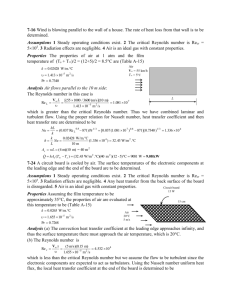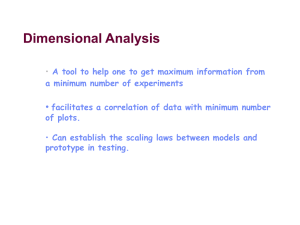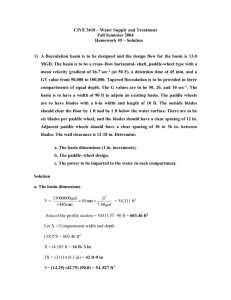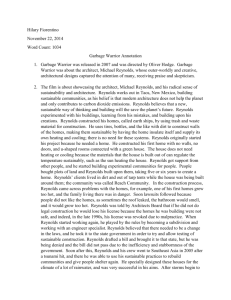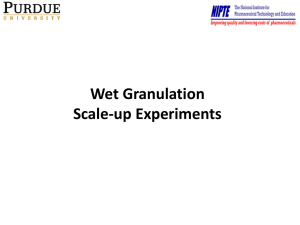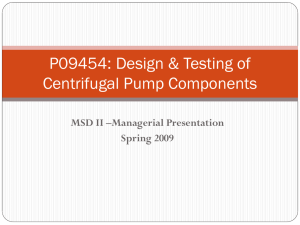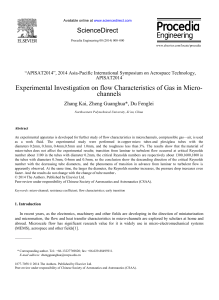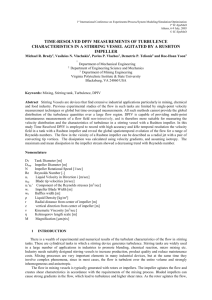Homework #4
advertisement
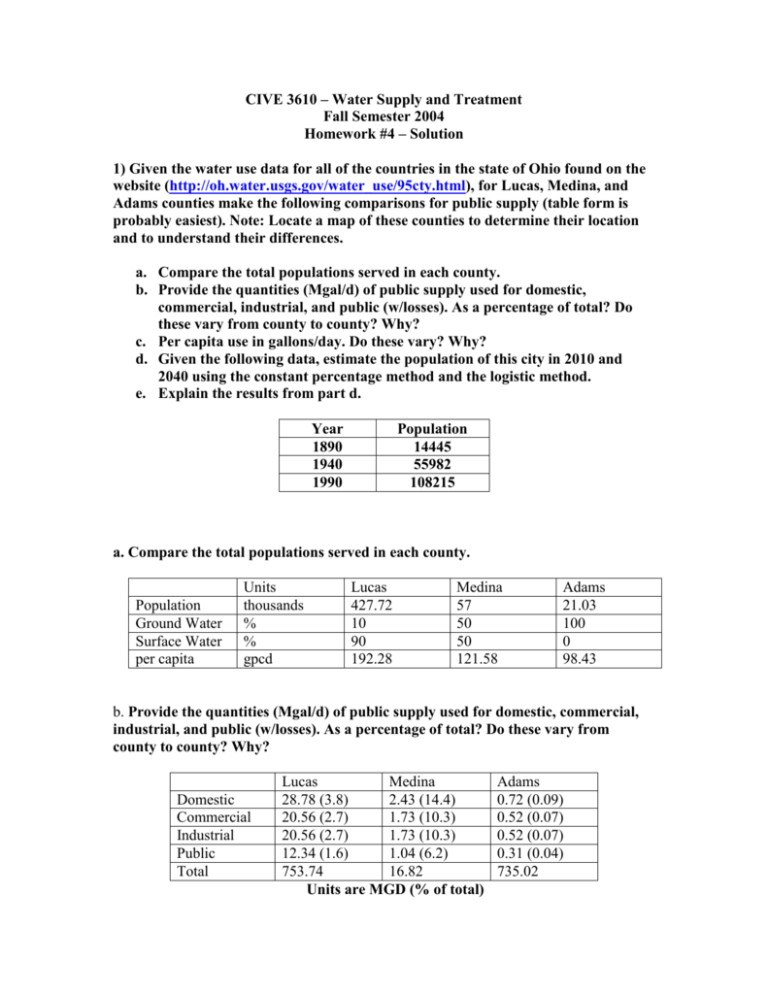
CIVE 3610 – Water Supply and Treatment
Fall Semester 2004
Homework #4 – Solution
1) Given the water use data for all of the countries in the state of Ohio found on the
website (http://oh.water.usgs.gov/water_use/95cty.html), for Lucas, Medina, and
Adams counties make the following comparisons for public supply (table form is
probably easiest). Note: Locate a map of these counties to determine their location
and to understand their differences.
a. Compare the total populations served in each county.
b. Provide the quantities (Mgal/d) of public supply used for domestic,
commercial, industrial, and public (w/losses). As a percentage of total? Do
these vary from county to county? Why?
c. Per capita use in gallons/day. Do these vary? Why?
d. Given the following data, estimate the population of this city in 2010 and
2040 using the constant percentage method and the logistic method.
e. Explain the results from part d.
Year
1890
1940
1990
Population
14445
55982
108215
a. Compare the total populations served in each county.
Population
Ground Water
Surface Water
per capita
Units
thousands
%
%
gpcd
Lucas
427.72
10
90
192.28
Medina
57
50
50
121.58
Adams
21.03
100
0
98.43
b. Provide the quantities (Mgal/d) of public supply used for domestic, commercial,
industrial, and public (w/losses). As a percentage of total? Do these vary from
county to county? Why?
Domestic
Commercial
Industrial
Public
Total
Lucas
Medina
28.78 (3.8)
2.43 (14.4)
20.56 (2.7)
1.73 (10.3)
20.56 (2.7)
1.73 (10.3)
12.34 (1.6)
1.04 (6.2)
753.74
16.82
Units are MGD (% of total)
Adams
0.72 (0.09)
0.52 (0.07)
0.52 (0.07)
0.31 (0.04)
735.02
In each case domestic use is highest and commercial and industrial are generally
equal. However, percent of TOTAL water use varies significantly. In all cases, domestic
use is low in comparison to total water use. In fact, domestic, commercial, industrial, and
public combined are less than 50% of total water usage. It should be noted that the total
usage takes into account thermoelectric, irrigation, livestock, private water supplies etc.
These different water demands in each county account for differences in % of total water
from county to county.
c) Per capita use in gallons/day. Do these vary? Why?
Per capita use (refer answer for (a)) in gallons/ day varies dramatically from 93 to 192
gpcd. The trend matches that of the total population in these counties (i.e., lowest to
highest use in accordance with the lowest to highest population). Economic conditions,
population density, and industrial development in Lucas County all contribute to the
higher per capita usage. In addition, it is more likely that residents in Toledo will use
water to maintain their lawns and plantings on their properties and that the municipality
requires more water to upkeep public properties.
d) Given the data, estimate the population of this city in 2010 and 2040 using the
constant percentage method and the logistic method.
Constant % method
Ln (P) = Ln (P0) + K ΔT
K = [Ln(P2)- Ln(P1)] / (T2- T1)
= [Ln (108215) – Ln (14445)] / (1990-1890)
= 0.02
2010
Ln (P) = Ln (108215) + 0.02 (20)
Ln (P) = 11.59 + 0.40
P2010 = 161,135
2040
Ln (P) = Ln (108215) + 0.02 (50)
Ln (P) = 11.59 + 1
P2040 = 293,608
Logistic Method:
PF = K/ (1+10(a+b x))
K= [(2* P1 * P2 * P3) – (P22 *(P1+P3))] / (P1*P3 -P22)
a = log [(K - P1 )/ P1 ]
b = 1/n [ log {P1 (K – P2 ) / P2 (K- P1)}]
K= [(2* 14445 * 55982 * 108215) – ((55982)2 * (14445+108215))] / (14445 * 108215-55982)2)
= 133121
a = log [(133121 - 14445 )/ 14445 ] = 0.91
b = 1/50 [ log {14445 (133121 – 55982 ) / 55982 (133121- 14445)}] = - 0.016
2010
P = 133121/ (1+10(0.91+(-0.016 * 120)) = 121270
2040
P = 133121/ (1+10(0.91+(-0.016 * 150)) = 128948
e) Explain the results from part d.
Constant percentage method assumes a constant rate of increase in growth rate. Logistic
method assumes the growth rate will level off over time. Therefore, answers calculated
by constant percentage method are higher than those calculated using logistic method.
Logistic method typically used for long term (>10-20 year) predictions.
2) The City of Buntsville has a present population of 51,511 and the average water
consumption is 147gpcd. Determine the future estimated consumption if the 10-year
projected population is 68,888.
[(P2 - P1)/ P1] * 100 % = [(68888 – 51511)/ 51511] * 100 % = 33.7 %
Therefore, future flows Q = 147 gpcd [100%+ (0.1%)* (33.7)] = 152 gpcd
3) A rapid mixing basin is to be designed for a water coagulation plant, and the
design flow for the basin is 4.0 MGD. The basin is to be square with a depth equal to
1.25 times the width. The velocity gradient is to be 900 sec-1 (at 50F), and the
detention time 30sec. Determine:
a. The basin dimension if increments of 1” are used.
b. The input horsepower required.
c. The impeller speed (KT = 5.75) if the impeller diameter is to be 50% of the
basin width.
d. Check the Reynolds number to validate your assumption.
a) The basin dimension if increments of 1” are used.
V= (4 *106 gal/1440 min) * (1min/60sec) *(30sec) * (1ft3/7.48 gal) =185.68 ft3
(W2)* (1.25 W) = 185.68
W = 5.30 ft, use 5 ft- 4 in
D = (5.33) * 1.25 = 6.66 ft, use 6 ft – 8 in
b) The input horsepower required.
G = (P/ μV)1/2
P/ μV = G2
P/V = μ * G2
P/V = (2.73 * 10-5 lb-sec/ ft2) (900 sec-1)2
= 22.113 ft-lb/sec-ft3
V = (5.33)2 * (6.67) = 189.49 ft3
P = (22.113 ft-lb/sec-ft3) * (189.49 ft3)
= 4190 ft-lb/sec
= 7.62 hp
550 ft-lb/sec = 1hp
c) The impeller speed (KT = 5.75) if the impeller diameter is to be 50% of the basin
width.
KT = 5.75
Di = (0.50)*(5.33 ft) = 2.665 ft
n = [(P * gc) / (KT * (Di )5 * γ )]1/ 5
n = [(4190ft-lb/sec)* ( 32.17 ft/sec2) / 5.75 * (2.665 ft) 5 * 62.4 lb/ft3 )] 1/ 5
= 1.23 rps = 73.7 rpm
d) Check the Reynolds number to validate your assumption.
Reynolds number, NRe
NRe = (Di2 * n * ρ)/ μ = (Di2 n γ) / μ*gc
= (2.665 ft)2 * (1.23 rps) * (62.4 lb/ft3 ) / (2.73 * 10-5 lb-sec/ ft2 )* ( 32.17 ft/sec2 )
= 621000>>> 10000
Thus, the flow regime is turbulent.
4) Please provide short answers to the following questions:
a. What is the primary purpose of flocculation? How does it differ from rapid
mix?
b. What is The key design parameter in mixing?
c. Provide a brief definition for Reynolds Number. Why is this value important
in water treatment? What factors could affect it?
a) What is the primary purpose of flocculation? How does it differ from rapid mix?
The primary purpose of flocculation is turbidity removal. The G values of flocculation
(35 to 70/sec) are MUCH lower than rapid mix (700-1000/sec) and the detention times
are longer (20-60 minutes vs. 20-60 seconds).
b) What is The key design parameter in mixing?
G, the velocity gradient or GT. G represents changes in water velocity from point to
point.
c) Provide a brief definition for Reynolds Number. Why is this value important in
water treatment? What factors could affect it?
Reynolds number is a dimensionless number interpreted as the ratio of inertial forces to
viscous forces in the fluid. Inertial forces are a function of flow diameter, velocity, and
fluid density. Viscous force is represented by fluid’s absolute viscosity. Reynolds number
is important in water treatment because the flow conditions (laminar vs. turbulent) will
help to determine power required for adequate mixing. Reynolds number created by a
mixer/ impeller can be affected by water temperature, diameter of the impeller, and
rotational speed of the impeller.
Extra Credit: The mean velocity of 40oC water in a 44.7 mm (inside diameter) tube
is 1.5 m/s. The kinematic viscosity is 6.48 x 10-7 m2/s. What is the Reynolds number?
(MUST have the correct answer and show work)
i.
ii.
iii.
iv.
8.13 x 103
8.54 x 103
9.06 x 104
1.02 x105
Reynolds Number NRe = ρVD/ μ = VD/ υ
= (1.5m/s) * (44.7*10-3 m) / 6.48 x 10-7 m2/s
=1.03 * 105
Answer: 1.02 x105
